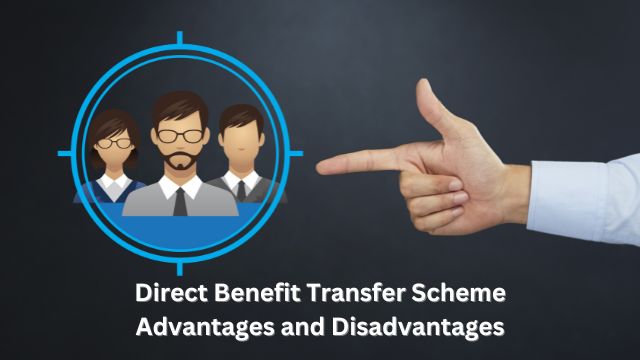The welfare programs require a lot of transparency. Specially when it comes to social welfare initiatives, then such options are quite important. The Direct Benefit Transfer or DBT has come up as a very important part of this whole process. Not only that this process ensures the subsidies and benefits through direct transfer, but also that the process negates any chance of intrusion of any intermediaries. As a result of that, the system runs with full assurance that the deserved persons will have the full benefit of the plans. Here are the essential advantages and a few disadvantages that you would need to know about this process.

Advantages of DBT Scheme
1. Reduced Leakages and Corruption:
The new welfare distribution mechanism Direct Benefit Transfer (DBT) transfers subsidies and payments directly into qualifying recipients’ bank accounts. We remove intermediaries, reduce leakages, and boost social welfare program efficiency using this method. To comprehend its influence on different socioeconomic contexts, assess its merits and downsides. The key advantage of DBT is decreasing leaks and corruption. Direct benefit transfers prevent theft and guarantee subsidies reach their beneficiaries. DBT mandates bank accounts, promoting financial inclusion and formal banking. Customers get financial services and the government monitors transactions. DBT tracks bank transactions via transparency. System accountability and public trust in government are enhanced by transparency. Targeting improves welfare program resource allocation and effectiveness.
2. Financial Inclusion:
DBT is essential to the government’s financial inclusion aim. DBT beneficiaries must have a bank account to encourage formal banking. It empowers consumers by offering a range of financial services. DBT requires bank accounts to empower users economically and facilitate government transfer monitoring and control. Beneficiaries’ formal banking establishes a trackable money route. This coordinated approach boosts financial inclusion, welfare security, and transparency. DBT promotes bank account formation and usage beyond subsidy payments. A more comprehensive financial ecosystem including savings, loans, and digital transactions is created. Multimodal engagement in the formal financial industry enhances financial literacy and economic progress.
3. Transparent and Traceable Transactions:
Direct Benefit Transfer (DBT) emphasizes openness over traditional welfare distribution. Benefit transfers are traceable and auditable since all transactions use banking channels. This transparency ensures system accountability and prevents benefit loopholes. DBT sends subsidies and perks via banks for transparency. Traceability helps audits and monitor money utilization. Accountability prevents stealing and fraud in conventional assistance systems. Open DBT boosts public trust in government initiatives. Since each transaction is recorded and confirmed, users can trust their entitlements are distributed efficiently and without interference. Being transparent about social programs decreases the likelihood of unscrupulous people exploiting them.
4. Customized Targeting:
Direct Benefit Transfer (DBT) changes the paradigm by targeting income, demographics, and socioeconomic status. This method better identifies needy individuals than welfare systems’ random distribution. Through beneficiary selection, DBT provides subsidies and benefits to the needy. A longstanding welfare administrative issue is solved via DBT focused customization. Due to a lack of beneficiary criteria, traditional methods failed to support individuals who needed it. DBT targets the process precisely, reducing over- and under-inclusion. A more accurate beneficiary selection influences resource allocation optimization. DBT limits support to qualified people based on defined criteria, reducing resource waste. These tailored techniques increase welfare program efficacy by focusing limited resources. Custom targeting enhances welfare and resource utilization. DBT addresses its target population to reduce poverty, improve healthcare, and educate. A tailored strategy promotes sustainable development and socioeconomic well-being.
Disadvantages of DBT Scheme
1. Technological Challenges:
Direct Benefit Transfer (DBT) requires robust technological infrastructure and internet connection, which may be missing in certain locations. DBT difficulties in remote and underdeveloped areas because recipients can’t access their bank accounts or comprehend digital transactions. This hinders the scheme’s beneficiary reach. High-tech DBT frameworks may leave remote or impoverished areas without the infrastructure to implement them. Poor technology prohibits recipients from fully engaging in the scheme and receiving and administering direct payments. Receivers struggle without internet connectivity in remote areas. Poor internet connections make online banking and bank account access difficult for people. In places with poor technology, DBT’s stated benefits—streamlined welfare distribution and financial inclusivity—are impeded. DBT needs targeted digital divide interventions to equalize technological access and skill. To ensure DBT users have the tools and connectivity to benefit, governments and implementing organizations must prioritize infrastructure development in disadvantaged communities. Improving internet connectivity, digital literacy, and mobile technologies may aid areas with limited financial services.
2. Exclusion Errors:
Direct Benefit Transfer (DBT) seeks for welfare administrative accuracy, yet exclusion errors may exclude eligible persons. This risk is created by inaccurate databases, beneficiary unawareness, and paperwork difficulties. These problems undermine the DBT system’s inclusivity, denying needy individuals important advantages. DBT exclusion errors depend on database quality and consistency. Due to incomplete or faulty databases, beneficiary selection may overlook eligible people. Data mistakes might impair targeted charity delivery by excluding the really poor. Beneficiary unawareness is another key concern. Uninformed people may not actively seek DBT involvement due to welfare program, application, or qualifying constraints. Ignorance may eliminate qualified applications, increasing the likelihood of exclusion errors. Poor documentation worsens exclusion errors. If documentation requirements are tight, DBT applicants who struggle to collect or preserve paperwork may be disqualified. This bureaucratic hurdle disproportionately affects underprivileged groups who cannot afford or manage sophisticated paperwork. These challenges need proactive solutions to prevent exclusion errors. Governments and implementing agencies must update and correct databases, educate potential beneficiaries, and simplify papers for accessibility. Technology-based outreach and application procedures may eliminate exclusion errors and guarantee DBT benefits those who need it most.
3. Banking Access Disparities:
Banking access inequalities may increase if DBT benefits are paid from bank accounts. This issue is worse in locations with limited financial infrastructure and trouble acquiring bank account paperwork. Thus, the DBT strategy may mistakenly omit a huge portion of the population, particularly in rural and disadvantaged regions. Banking infrastructure is rare in disadvantaged places, restricting financial services. Lack of branches and ATMs may make opening and utilizing bank accounts difficult for rural residents. The geographical mismatch in banking infrastructure exacerbates the urban-rural divide, making DBT adoption in low-income areas challenging. Complexity increases with bank account documentation. Due to restricted educational alternatives or bureaucratic issues, rural and marginalized populations may lack the necessary documentation. This bureaucratic burden deters qualifying recipients from joining DBT and denies them vital financial aid. The accidental exclusion of a significant group underscores the need for a more inclusive DBT approach. Governments and implementing agencies should consider mobile banking and alternative identifying methods for DBT users without documentation. Banking infrastructure in poor regions and financial education may potentially minimize banking access inequalities and make DBT fairer.
4. Privacy Concerns:
Privacy and security considerations arise while collecting and storing beneficiary data for Direct Benefit Transfer (DBT). This approach obtains sensitive personal data, presenting abuse risks. Governments must aggressively secure beneficiary data from unauthorized usage to ensure DBT program integrity. Privacy concerns stem from DBT’s enormous personal data storage. Financial and demographic beneficiary data is important and must be secured. Governments must value and safeguard this data. Strong measures are required to protect privacy. Governments need encryption, access limitations, and periodic audits to secure data storage systems. Implement rigorous authentication to prevent unauthorized usage of beneficiary data.
5. Dependency on Banking System:
Direct Benefit Transfer (DBT) performance depends on banking efficiency and reliability. Financial infrastructure is needed to transfer benefits directly to beneficiaries’ accounts. However, technological faults, server downtimes, and banking service outages may delay benefit transfer. Disruptions may hurt recipients financially and undermine DBT aims. Bank infrastructure dependence highlights the necessity for a strong and inclusive financial system. Technical difficulties or system downtimes may delay fund transfers, preventing recipients from getting payments. This delay may affect those who need emergency financial help for healthcare, education, or food. The DBT scheme’s success depends on banking system stability.
Conclusion
As you can well understand, This DBT system has become the cause of a huge change in the process of ensuring welfare for people. Like any other initiative this process has some pros and cons and those in control of these schemes are fully aware of the same. This is why proper transparency is of utmost importance in case of these schemes and the concerned authority should be aware that the deserved persons are getting the fruits of their works.

Meet Suhas Harshe, a financial advisor committed to assisting people and businesses in confidently understanding and managing the complexities of the financial world. Suhas has shared his knowledge on various topics like business, investment strategies, optimizing taxes, and promoting financial well-being through articles in InvestmentDose.com


